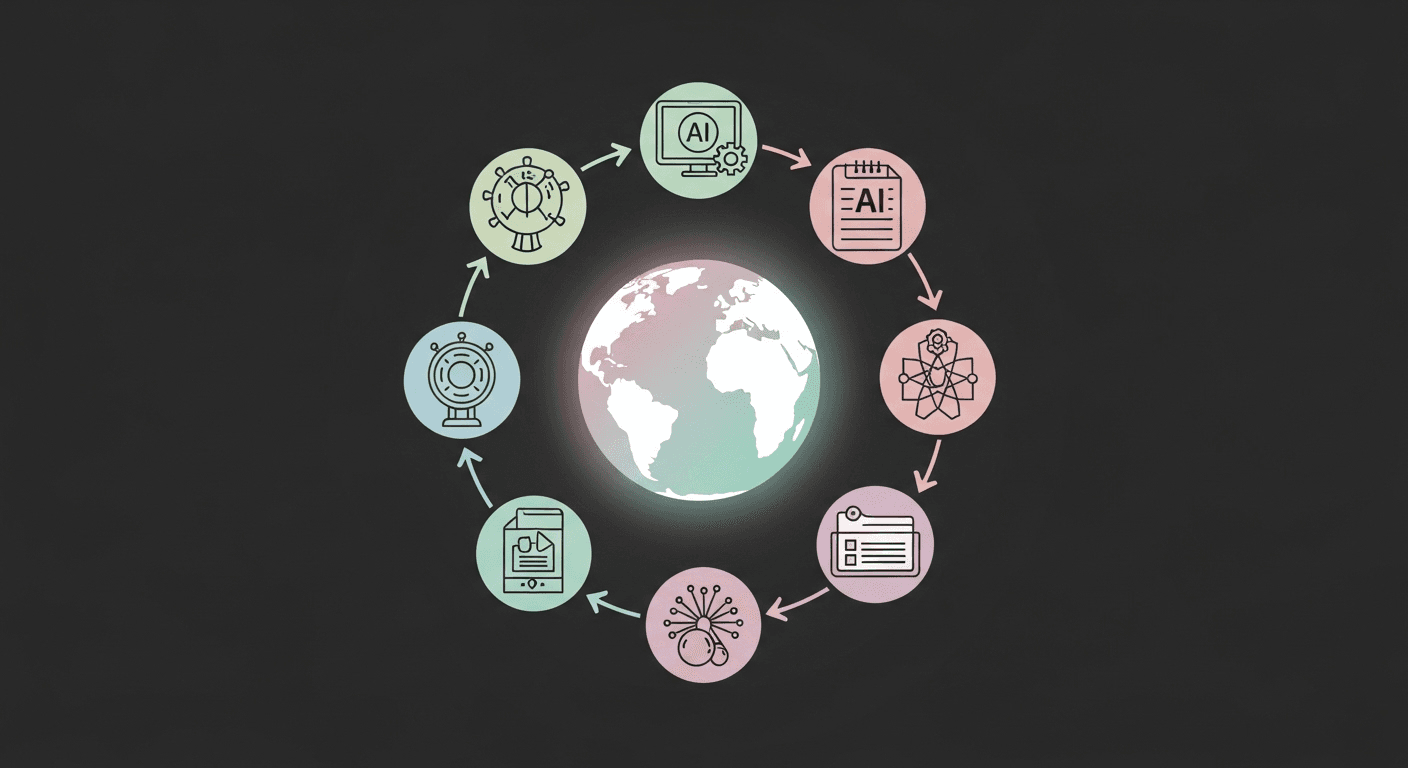5 AI Stories Shaping Business Today: Power, Data Debt, Tariffs, Penthouses, and the Context Gap

5 AI Stories Shaping Business Today: Power, Data Debt, Tariffs, Penthouses, and the Context Gap
Wondering what made headlines in AI this week? On October 17, 2025, The Wall Street Journal highlighted five compelling themes that every business leader should keep an eye on. From the towering demands of power-hungry data centers to the quirky issue of data debt, AI tools that mitigate tariff shocks, luxury penthouses being marketed with generative video, and the increasing context gap that hampers AI effectiveness at work—this brief summarizes these trends with practical insights.
Below, you’ll find concise sections for quick reading, each backed by credible reporting and research, along with actionable strategies for compliance, risk, and strategy teams.
1) Bring Your Own Power: AI Data Centers Invest in On-Site Generation
The demand for AI computing surpasses what the U.S. power grid can provide. New data centers—particularly those optimized for AI—are increasingly constructing their own power plants or fuel-cell facilities to ensure timely project delivery and predictable costs. According to the Journal, operators are turning to on-site natural gas and fuel cells to overcome grid limitations and permitting delays. Some projects plan to run partially or entirely off-grid to enhance reliability and speed.
In regions like Texas and the Permian Basin, this trend is especially pronounced, with AI developers establishing themselves near gas supplies, staging major projects, and securing hundreds of megawatts of capacity years in advance. A recent WSJ report revealed a West Texas project that aims to self-generate power while ramping up to a multi-hundred-megawatt capacity, representing the confluence of computing, energy, and real estate.
What this means for leaders:
– Energy strategy must be prioritized alongside AI initiatives. Approach power as you would a supply chain: diversify your sources, negotiate long-term contracts, and model scenarios for price fluctuations and outages.
– Compliance and ESG considerations are now essential in infrastructure planning. Assess permits and environmental impacts before breaking ground.
– Contracts require updated clauses. Include specifics on energy curtailment, carbon accounting, and failover obligations for both grid and on-site generation.
Recent industry updates confirm the BYOP (bring-your-own-power) trend, particularly in Texas, highlighting the urgent need for reliable and scalable energy sources for AI clusters.
2) Understanding Data Debt — The Hidden Barrier to AI ROI
Just as technical debt refers to costs incurred from quick software fixes, data debt represents the challenges associated with scattered, outdated, or poorly governed data that hampers AI effectiveness and increases compliance risks. Issues like duplicate records, absent lineage, and manual spreadsheets that drive essential processes can slow down operations significantly.
Experts have pointed out that inconsistent data quality and fragmentation are primary culprits behind stalled AI initiatives. The solution isn’t flashy: it involves unifying critical data domains, defining ownership, continuously monitoring quality, and ensuring governance aligns with actual business needs. This foundation is vital for successful AI deployment.
Steps to reduce data debt quickly:
– Focus on 2 or 3 key data domains critical to revenue or risk (e.g., customers, products, suppliers). Assign owners and establish Service Level Agreements (SLAs) for data integrity and accuracy.
– Create a basic shared glossary. Standardize definitions and usage. Inconsistent terminology across systems leads to confusion and errors.
– Integrate quality control measures. Implement automated checks for duplicates, errors, and missing entries; direct issues to the appropriate teams for timely resolution.
– Align governance with results. Elevate issues that hinder key use cases—like sanctions screening or pricing adjustments—to higher management levels.
From an executive viewpoint: AI amplifies your existing data issues. If your data is flawed, AI will highlight those flaws in even more apparent and costly ways.
3) Closing Multi-Million Dollar Deals with AI’s Help
Luxury real estate and AI may seem unrelated, but agents are increasingly combining AI-generated media, marketing content, and data analytics to hasten sales processes and tailor client interactions. The Journal showcased a brokerage that developed an in-house AI platform capable of drafting emails, generating market analyses, and producing cinematic visuals of properties. Many agents have adopted this tool, reporting significant time savings alongside record sales volumes in 2025.
A noteworthy transaction involved an AI entrepreneur acquiring a $38.2 million triplex in Miami, illustrating how tech wealth is influencing the luxury real estate market. While one sale isn’t indicative of a trend, it underscores the economic ripple effects of AI in various sectors.
Practical insights:
– Regulatory guidelines still apply. If AI generates marketing communications, ensure compliance with fair housing and advertising regulations.
– Data management is crucial. Automate your Customer Relationship Management (CRM) system to log sources and consent, and train your team on privacy principles when employing AI tools.
– Evaluate impact beyond mere volume. Monitor metrics such as cycle time, response rates, and conversion rates from listing to sale.
4) Leveraging AI for Tariff Management and Trade Shocks
With trade reliability becoming increasingly uncertain, logistics and brokerage platforms are integrating AI tools to monitor classification, simulate scenarios, and flag compliance risks in real time for importers and manufacturers. Such technologies can help reduce duties and avoid costly misclassifications.
This year, companies are beginning to harness AI for mapping complex supply chains, applying tariff changes across product portfolios, and predicting costs. Although still in its infancy, it’s evident that AI is transitioning from merely providing oversight to offering concrete decision-making support in trade compliance.
Key questions for your team:
– Is there a consolidated source of truth for your Harmonized System (HS) codes, rules of origin, and supplier confirmations? How is this information governed?
– Are you equipped to simulate policy changes and evaluate exposure at the SKU and lane levels?
– Where are you still dependent on manual data entry or communication for customs information? These areas present risks where AI can offer solutions—assuming the data is reliable.
5) Navigating the Context Gap: Why AI Sometimes Misses the Mark
Despite advancements in AI models, users often find that the systems lack sufficient contextual understanding of their unique environment—policies, definitions, and historical decisions—to deliver accurate responses consistently. This context gap accounts for discrepancies in outcomes from equivalent prompts and why AI assistants often stumble with company-specific queries.
Two factors contribute to this gap:
– Limited context windows. Models can only digest so much information at once, and extending these limits can be costly. Research and new tools aim to expand or optimize context windows without sacrificing quality.
– Scattered knowledge. Insights are dispersed across various platforms like SharePoint, email, wikis, and ticket systems. Without effective retrieval methods, assistants may only speculate. Startups and academic groups are exploring designs that anchor AI feedback to specific timeframes and retain context as documents change.
Recent industry reports highlight tools designed specifically for managing long-context scenarios and office workflows, emphasizing that value stems from consistent context management rather than merely smarter models.
Strategies to close the gap:
– Treat context as an asset. Create a curated knowledge base with versioned policies, established definitions, and approved examples.
– Integrate robust retrieval methods. Use retrieval-augmented generation (RAG) that cites sources and maintains logs for audits.
– Pilot in focused areas with clear rules. Initial successes can include policy Q&A, product specifications, and playbooks where accuracy can be directly measured.
– Track changes regularly. As policies and products evolve, discard outdated content and update system embeddings periodically.
What’s the Big Picture?
- Power generation is evolving into a strategic critical factor. Anticipate an increase in on-site generation, energy partnerships, and location-based strategies that consider fuel availability and regulatory realities.
- Data debt is quietly undermining AI ROI. Effective teams are prioritizing data fundamentals in addition to the latest models.
- AI is finding its way into surprising areas—from customs compliance to luxury marketing—where it expedites workflows but heightens governance challenges.
- The context gap is a significant hurdle in many AI initiatives. Addressing it involves establishing processes and tools to manage knowledge effectively, not just employing larger models.
If you’re responsible for compliance, risk, or operations, the takeaway is clear: lay the groundwork first. Secure your power sources, streamline your data, and structure your context. Then scale your pilot programs into sustainable operations with tangible business benefits.
Quick Actions Checklist
- Map your top 5 AI applications to specific data sources, responsible stakeholders, and quality measures.
- Integrate energy risk into your AI planning: consider sourcing, curtailment policies, and carbon impact.
- Create a compliance sandbox for trade scenarios to quantify tariff risks.
- Launch a grounded Q&A assistant within a well-managed knowledge base; track accuracy and escalation processes.
- Develop an AI registry: document purpose, data sources, associated risks, controls, and performance indicators for each AI system.
Sources and Further Reading
- AI data centers are turning to on-site generation for power.
- West Texas AI data center project will self-generate power while staging capacity.
- Luxury real estate companies are leveraging in-house generative AI platforms to enhance sales and save time.
- AI tools are equipping importers to manage tariffs and compliance risks.
- Addressing context: insights into long-context models and office systems designed around context management.
- The significance of managing data debt and technical debt in AI initiatives.
FAQs
What is data debt in plain terms?
Data debt refers to the accumulating costs associated with messy, incomplete, or siloed data. Similar to technical debt in software, it delays your progress later—especially during AI implementation. You can reduce it by consolidating critical data, defining clear ownership, and continuously monitoring quality.
Are AI data centers genuinely building their own power plants?
Yes. To circumvent grid constraints and ensure reliability, some AI data centers are incorporating gas turbines or fuel cells to generate part or all of their energy, particularly in rapidly developing areas like Texas.
How can AI assist with tariffs and customs?
Contemporary tools can analyze product catalogs, track classification variations, model duty implications, and identify compliance risks before shipments leave. The objective is to minimize errors and expedite imports.
What exactly is the AI context gap?
The context gap signifies the difference between a model’s general knowledge and your business-specific requirements. It manifests when assistants overlook policy nuances or forget prior decisions. Bridging it necessitates an organized knowledge base, effective retrieval methods, and periodic updates—not just a different model.
Is the application of AI in real estate simply hype?
There’s tangible momentum: agents are utilizing AI for drafting materials, creating visuals, and personalizing outreach in scale. Success relies on adherence to compliance measures, data quality, and performance tracking, just like any enterprise AI undertaking.
Conclusion
This week’s overarching themes from WSJ highlight a straightforward approach: Secure your energy sources. Enhance your data integrity. Engineer your contextual understanding. From there, let AI drive the important work forward. Organizations that adopt this strategy can transform AI from mere pilot programs into sustainable advantages.
Thank You for Reading this Blog and See You Soon! 🙏 👋
Let's connect 🚀
Latest Blogs
Read My Latest Blogs about AI

5 AI Stories Shaping Business Today: Power, Data Debt, Tariffs, Penthouses, and the Context Gap
A clear roundup of 5 AI trends shaping business now: power-hungry data centers, data debt, AI for tariffs, luxury sales with AI, and the context gap — with takeaways.
Read more


